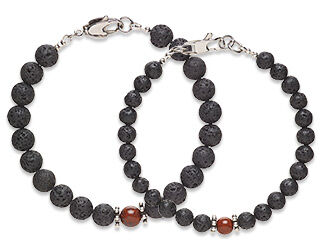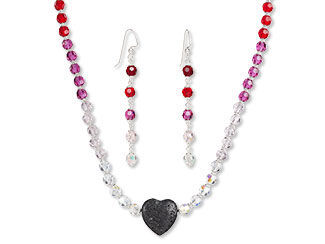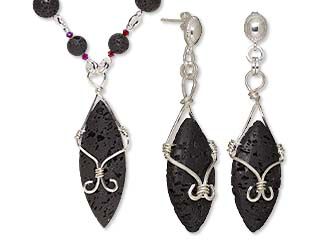Lava Meaning and Properties
Lava History
As the oldest stone in the world, lava has been used in jewelry by many cultures. The Victorian era saw an upsurge in lava jewelry production when cameos were at the height of popularity. Cameos were carved on pieces of lava from Mt. Vesuvius. During the 19th century, cameos were sought-after souvenirs for English ladies touring Italy. Although classical Roman and Greek gods and goddesses were usually carved into the cameos, a lady could commission one to be carved of herself. Lava jewelry is still popular in Italian souvenir shops and is often mixed with red coral. Jewelry-makers in Hawaii, New Zealand, Iceland, South and North America, and many more places make jewelry from volcanic rocks.
The word lava comes from the Latin word lavare which means to wash, or alternatively from labes which means to fall or slip--referring to the flash floods, or streams of lava spewing down from a volcano.
Taking lava rock from the Hawaiian Islands is shrouded in superstition. According to legend and mythology, it is taboo to take lava, pumice, or shells from the island as souvenirs. The belief is that Pele, the jealous and powerful goddess of fire and volcanos, rules over and protects the Hawaiian people and land. She considers the volcanic rocks to be her children. She curses violators with extreme misfortune until they return the materials. As a result of this belief many boxes of shells and lava rock are sent back to Hawaii every year.
Lava Metaphysical Properties
Lava is associated with the root chakra as, like roots, it comes from deep in the ground. The earthy qualities of lava make it a stone of grounding, focus and balance, materialism and restraint. Its fiery energy is associated with passion, assertiveness and energy. When you are drawn to lava you may be seeking energy and stamina. It is also said to be useful as a stone of detoxification, to dissipate anger and to clear negative energy. Crystal healers use it to help with anxiety, emotional tranquility, relaxation and a sense of calmness. It is said to be a "stress-absorber."
Lava's porous quality makes it popular to use as a diffuser in aromatherapy. Sprinkle a small stone with essential oils and wear it in a cage or filigree locket. The beneficial qualities of the oils and the lava will be with the wearer all day. Diffusers can also be used to keep cars smelling fresh.
Lava Geological Properties
Lava stone derives from magma, extremely hot molten rock from deep in the Earth. It is expelled from Earth's crust when it is heated to extremely high temperatures by geothermal energy. As temperatures reach roughly 700 to 1,200 °C (1,292 to 2,192 °F) magma is expelled through a vent, resulting in a lava flow on the outer crust of the Earth. The lava flow is a viscous, bubbling combination of crystals, gasses and liquids. As it cools and solidifies, it forms the igneous rock known as lava rock. Lava is a predominate rock on Earth, covering approximately 70% of the planet. Lava beads and components are made from the igneous rock basalt which is approximately 65% feldspar. It has a unique surface texture with pits and voids. It may have a glassy matrix and mineral grains within it.
|
|
|
|
|
|
|
|
|
|
|
|
|
|
|
|
|
|
Proper Care of Lava
If your lava beads get dirty, or you want to change the scent in your aromatherapy jewelry, simply rinse the beads in warm water with a very mild soap or Himalayan salt. Rinse to remove soap and let them dry. Keep away from chemicals and do not clean in ultrasonic cleaners.
Designing with Lava
Each lava bead with its pits and crevasses is unique and can be showcased. A lava pendant can be worn on a simple chain for an elegant minimalistic look. Lava's lightweight and interesting texture makes it great for mala beads and multi-strand designs. The red and black colors contrast well with all metals, and they are often used with hematite and cubic zirconia pave beads in men's jewelry. The porous matte finish contrasts well with tigereye, agate, lapis lazuli and turquoise. For organic designs, use with shell, bone and wood beads. They are very popular in power bracelet designs. You will often see lava beads mixed with the seven colors of the chakra in bracelet designs too.
The fact that you can add scent to the lava beads makes them good for aromatherapy. Many of the lava beads for jewelry making are waxed to make them feel smooth. If you want to make aromatherapy jewelry, you need to remove that wax so the essential oils can be absorbed. Submerge waxed lava beads in a bowl of hot water. Allow the beads to sit for approximately five minutes. Use tongs to remove the beads and place them in a paper towel. Rub beads with the towel to remove the wax coating. The beads will be much duller when the coating is removed. However, they will absorb essential oils and can be placed in a bead cage pendant component for a great-smelling necklace or car ornament.
A Few Design Inspirations to Get You Started
Shop for Lava
**Please note that all metaphysical or healing properties listed are collected from various sources. This information is offered as a service and not meant to treat medical conditions. Fire Mountain Gems and Beads® does not guarantee the validity of any of these statements.
How did you like this resource? Your feedback helps us provide resources that matter to you most.
Copyright Permissions
All works of authorship (articles, videos, tutorials and other creative works) are from the Fire Mountain Gems and Beads® Collection, and permission to copy is granted for non-commercial educational purposes only. All other reproduction requires written permission. For more information, please email copyrightpermission@firemtn.com.





